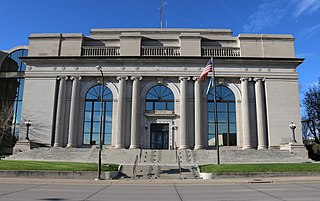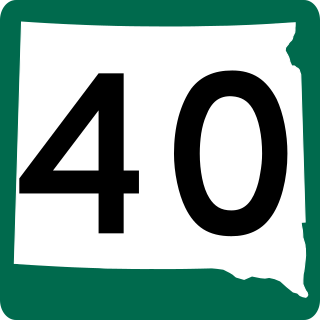History
Rockerville was founded in 1876 as the result of a gold rush. [1]
It was a tourist town in the 1950s and 1960s because of its key location on US Highway 16 between Rapid City and Mount Rushmore National Memorial. It had a variety of tourist attractions, including a "Mellerdrammer" (Melodrama) live theatre, a "Ghost town" of various buildings with tourist shops and small amusements, "It's a Small World" Museum (featuring an 1880 Tiny Town model and other miniature collections), a motel, campgrounds and RV parks. However, in the conversion of US Highway 16 to four lanes in the mid-1960s, the original townsite was placed between the two separate roadways, as there was no way to widen the original highway through the town without completely destroying it. With construction of at least three exits into the town from both directions, the town continued to be a vibrant tourist attraction in the 1970s and 1980s. The tourist could take in daily wild west shows, shootouts, stagecoach rides and gold panning. Fine dining was and still is available at the Gaslight Restaurant. Travelers could stay in town at the local Trading Post Motel, buy groceries and gas up their cars at the Rockerville Trading Post.
In the 1990s, the town virtually died, as a lack of visibility to tourists. The 55mph speed limits on the highway contributed to motorists driving past the town without stopping, sending the economy into a nosedive from which it never recovered. The only remaining business within the generally accepted city limits is the Gaslight Saloon, which was recently rebuilt after a devastating fire. Virtually all the older tourist-era businesses have long since closed, fallen into decay, and been demolished. This severe local economic damage today is sometimes referred to in South Dakota as "Rockerville Syndrome" and has had a significant bearing in the construction of new bypasses and highway improvements as recently as 1998 and 2001, in and around such small towns as Hill City and Corson.
Geography
Today, several subdivisions and rural residential areas have been built around Rockerville, which also has a sawmill and other commercial activities, leaving the small town rather like a doughnut. It is located close enough to Rapid City, Hill City, and Keystone to serve as a bedroom community. A larger commercial area has grown up on US Highway 16 approximately 1 mile east, known as "East Rockerville" or "Rockerville Flats" with various tourist-oriented businesses and more residential areas.
To the west, on the old alignment of US Highway 16, now called Silver Mountain Road, is the rural community of Silver Mountain, including Storm Mountain Center, a United Methodist camping facility. The Flume Trail, a hiking trail following the alignment and remains of a water flume built to provide water for those gold rockers in the 1880s, connects Rockerville, Storm Mountain, and Boulder Hills with Sheridan Lake, deeper in the Hills. Also, the west is Beretta Gulch, US Forest Service land well known to locals as a popular shooting range, and the Keystone Wye, where US 16 and US 16A divide, and famous for what was once the world's largest timber arch bridge.

Pennington County is a county in the U.S. state of South Dakota. As of the 2020 census, the population was 109,222, making it the second most populous county in South Dakota. Its county seat is Rapid City. The county was created in 1875, and was organized in 1877. It is named for John L. Pennington, fifth Governor of Dakota Territory, who held office in 1875 when the county was formed.

Hill City is the oldest existing city in Pennington County, South Dakota, United States. The population was 872 at the 2020 census. Hill City is located 26 miles (42 km) southwest of Rapid City on U.S. Highway 16 and on U.S. Route 385 that connects Deadwood to Hot Springs. Hill City is known as the "Heart of the Hills", a distinction derived from its proximity to both the geographical center of the Black Hills, and the local tourist destinations.

Keystone is a town in the Black Hills region of Pennington County, South Dakota, United States. The population was 240 at the 2020 census. It had its origins in 1883 as a mining town, and has since transformed itself into a resort town, serving the needs of the millions of visitors to the Mount Rushmore National Memorial, which is located just beyond the town limits. Keystone was heavily damaged in the 1972 Black Hills flood.

Rapid City is a city in South Dakota, United States, and the county seat of Pennington County. It is the second most populous city in the state, after Sioux Falls. It is located on the eastern slope of the Black Hills in western South Dakota and was named after Rapid Creek, where the settlement developed. The population was 74,703 as of the 2020 census.

U.S. Highway 16 (US 16) is an east–west United States Numbered Highway between Rapid City, South Dakota, and Yellowstone National Park in Wyoming. The highway's eastern terminus is at a junction with Interstate 90 (I-90)/US 14, concurrent with I-190, in Rapid City. The western terminus is the east entrance to Yellowstone National Park, concurrent with US 14 and US 20. US 16 used to extend all the way to Michigan but has been truncated in favor of I-90 and I-96.
Three Forks is an unincorporated community in Pennington County, South Dakota, United States. It lies at the intersection of U.S. Routes 16 and 385, just north of Hill City along Spring Creek. A small general store featuring fuel is open year-round; other businesses are open seasonally, including a campground, a motel, a miniature golf-course, and an ice-cream stand. The campground is the site of an annual Octoberfest event, and the area is heavily patronized during the Sturgis Motorcycle Rally in August of each year. In recent years, considerable residential development of the immediate area has swollen its population.

Keystone Wye is an interchange of U.S. Route 16 (US 16) and US 16A located in the Black Hills of South Dakota, featuring two unique structural glued laminated timber bridges. The Keystone Wye is a three-level Directional T interchange for the two divided highways, constructed in 1967–1968 as part of a project by the South Dakota Department of Transportation (SDDOT) to convert US 16 to a four-lane highway between Rapid City and Keystone. It was designed by Clyde Jundt and Kenneth C. Wilson.

U.S. Highway 16A (US 16A) is a 36.971-mile (59.499 km) scenic United States Numbered Highway. It is an alternate route for US 16. It splits from US 16 in the Black Hills of the southwestern part of the U.S. state of South Dakota. The highway's western terminus is an intersection with US 16, US 385, and South Dakota Highway 89 (SD 89) in Custer. The eastern terminus is at an interchange with US 16 called Keystone Wye south of Rapid City. Portions of US 16A are known as the Iron Mountain Road, named after the peak it summits.
The Rimrock Area is a suburban area of Rapid City, South Dakota located along South Dakota Highway 44 and Rapid Creek in the eastern Black Hills, between Rapid City and US-385. The area consists of a series of rural residential areas, subdivisions of various sizes, and old towns, including:
Johnson Siding is an unincorporated community in Pennington County, South Dakota, United States. The population as of the 2020 census was 614. It is located in the Rimrock Area, approximately 10 miles west of Rapid City. Johnson Siding is surrounded by the Black Hills National Forest. It is the only significant business district in the Rimrock Area, with a gas station/general store, deli, casino, tavern, the Johnson Siding Volunteer Fire Department firehouse, the Rimrock Evangelical Free Church meetinghouse, and a community center. However, most inhabitants work in Rapid City or Deadwood.

South Dakota Highway 244 (SD 244) is a short state highway located entirely within Pennington County, South Dakota which provides access to Mount Rushmore. Highway 244 runs generally east–west between its eastern terminus at US 16A near Keystone and its western terminus at US 16/US 385 south of Hill City. The entire route is part of the Peter Norbeck Scenic Byway. SD 244 does not connect to its parent route.

The Rapid City, SD metropolitan area, as defined by the United States Census Bureau. Anchored by the city of Rapid City, the area corresponds to the entirety of Pennington and Meade counties in the state of South Dakota, though the Rapid City market area extends well beyond those counties and into Nebraska, Montana, Wyoming, and North Dakota. The population was 139,074 at the 2020 census. According to 2022 census estimates, the MSA is estimated to have a population of 145,159.

South Dakota Highway 40 (SD 40) is a state highway in southwestern part of the US state of South Dakota. The highway is just over 37 miles (60 km) long and runs from U.S. Route 16A (US 16A) in Keystone to Bureau of Indian Affairs Highway 41 (BIA 41) in Red Shirt. The highway runs near Mount Rushmore National Memorial in Keystone, and its eastern terminus is on the Pine Ridge Indian Reservation near the edge of Badlands National Park.

The Black Hills is an isolated mountain range rising from the Great Plains of North America in western South Dakota and extending into Wyoming, United States. Black Elk Peak, which rises to 7,242 feet (2,207 m), is the range's highest summit. The name of the range in Lakota is Pahá Sápa. It encompasses the Black Hills National Forest. It formed as a result of an upwarping of ancient rock, after which the removal of the higher portions of the mountain mass by stream erosion produced the present-day topography. The hills are so called because of their dark appearance from a distance, as they are covered in evergreen trees.
Addie Camp, also known as Kennedyville, Addie Spur, or Canadaville, is a ghost town located in Pennington County, South Dakota, United States. It was a mining camp in the Black Hills that was active from the early 1880s until the 1910s.
Etta, also known as Etta Camp and Etta Mine, is a ghost town in Pennington County, South Dakota, United States. It was a successful mining town, known for its discovery of the largest spodumene crystal ever found.
Pactola, also known as Camp Crook, (1875–1950s) is a ghost town in Pennington County, South Dakota, United States. It was an early placer mining town and existed into the early 1950s, when it was submerged under Pactola Lake.
Rochford is an unincorporated community in Pennington County, South Dakota, United States. It is not tracked by the U.S. Census Bureau.
Redfern is the site of an old Black Hills Gold Rush community. The area is located at the eastern base of Redfern Mountain, 6,076 feet in elevation, in Pennington County, South Dakota. The mountain and the Redfern townsite is located on the gravel road to Mystic, South Dakota, and is about a mile from the old town site of Tigerville. The Mystic Road is approximately miles from Hill City on the Deerfield Road.

U.S. Highway 16 (US 16) is a 69-mile-long (111 km) east–west United States Numbered Highway in the western part of the state of South Dakota. It travels between Yellowstone National Park near Newcastle, Wyoming and Interstate 90 (I-90) in Rapid City.













